The Hidden World of Horseshoe Crab Conservation
Horseshoe crabs, ancient mariners of our oceans, have silently witnessed the rise and fall of countless species over millions of years. These living fossils now face unprecedented challenges, prompting a surge in conservation efforts. From their crucial role in medical research to their impact on shorebird populations, horseshoe crabs are at the center of a complex ecological and economic web. This article delves into the fascinating world of horseshoe crab conservation, exploring the innovative strategies and unexpected partnerships forged to protect these remarkable creatures.

However, these living fossils now face numerous threats. Habitat loss due to coastal development, pollution, and climate change has significantly impacted horseshoe crab populations. Over-harvesting for bait in the fishing industry and biomedical research has further strained their numbers. The decline of horseshoe crabs has far-reaching consequences, affecting not only marine ecosystems but also human health and the survival of migratory shorebirds.
The Blue Blood Revolution
One of the most intriguing aspects of horseshoe crab conservation is tied to their unique blue blood. This azure fluid contains a compound called Limulus Amebocyte Lysate (LAL), which is crucial for detecting bacterial contamination in medical products. The biomedical industry harvests horseshoe crabs for their blood, a process that, while not always fatal, can impact their health and reproductive success.
Efforts to develop synthetic alternatives to LAL have gained momentum in recent years. Recombinant Factor C (rFC), a laboratory-produced substitute, has shown promise in reducing the need for horseshoe crab blood. However, the transition to synthetic alternatives faces regulatory hurdles and resistance from some sectors of the pharmaceutical industry. The estimated market value of the LAL industry exceeds $500 million annually, highlighting the economic stakes involved in this conservation challenge.
Shorebirds and Spawning: An Ecological Dance
The fate of horseshoe crabs is inextricably linked to that of several migratory shorebird species, particularly the red knot. These birds time their spring migration to coincide with horseshoe crab spawning events, feasting on the nutrient-rich eggs to fuel their long-distance flights. The decline in horseshoe crab populations has led to a corresponding decrease in red knot numbers, prompting conservationists to focus on protecting critical spawning habitats.
Innovative approaches to habitat restoration have emerged, including the creation of artificial spawning beaches and the installation of specialized shoreline structures to reduce wave action and erosion. These efforts not only benefit horseshoe crabs but also support the entire coastal ecosystem, from tiny invertebrates to fish and birds.
Tagging and Tracking: Citizen Science in Action
Conservation efforts have been greatly enhanced by the involvement of citizen scientists in tagging and tracking programs. These initiatives allow researchers to gather valuable data on horseshoe crab movements, population dynamics, and spawning behaviors. Volunteers, armed with specialized tags and data collection tools, participate in annual surveys during spawning seasons.
The Delaware Bay Horseshoe Crab Tagging Program, one of the largest of its kind, has tagged over 500,000 crabs since its inception. This long-term dataset has provided crucial insights into population trends and helped inform management decisions. The program has also fostered a sense of stewardship among coastal communities, raising awareness about the importance of horseshoe crab conservation.
Balancing Acts: Policy and Management Challenges
Effective conservation of horseshoe crabs requires navigating a complex web of competing interests and jurisdictions. Fisheries management, biomedical research needs, and ecological preservation must all be balanced. In the United States, the Atlantic States Marine Fisheries Commission oversees horseshoe crab management, implementing quotas and restrictions on harvesting.
International efforts to protect horseshoe crabs have also gained traction, with species in Asia facing similar threats. The IUCN Horseshoe Crab Specialist Group coordinates global conservation initiatives, promoting research, sustainable use practices, and habitat protection across the species’ range.
The Future of Living Fossils
As we look to the future, the conservation of horseshoe crabs stands at a critical juncture. Advances in synthetic alternatives for medical testing offer hope for reducing the pressure on wild populations. Meanwhile, habitat restoration projects and stricter harvesting regulations are showing positive results in some areas.
Education and public engagement remain key to long-term conservation success. Initiatives like the Horseshoe Crab Festival in Delaware and eco-tourism programs focused on spawning events are helping to raise awareness and foster a connection between people and these ancient creatures.
The story of horseshoe crab conservation is one of interdisciplinary collaboration, innovative science, and community involvement. As we work to protect these living fossils, we are not only preserving a piece of Earth’s biological heritage but also safeguarding the intricate ecological relationships that sustain coastal ecosystems. The future of horseshoe crabs serves as a testament to our ability to balance human needs with the preservation of nature’s wonders.





